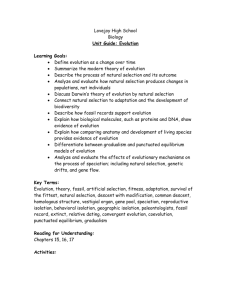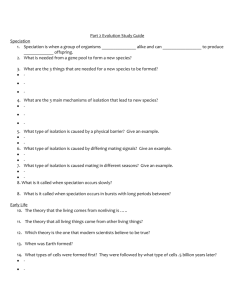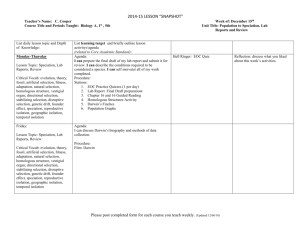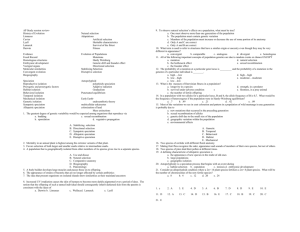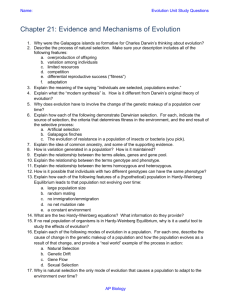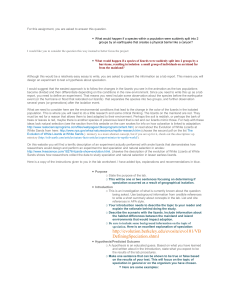File
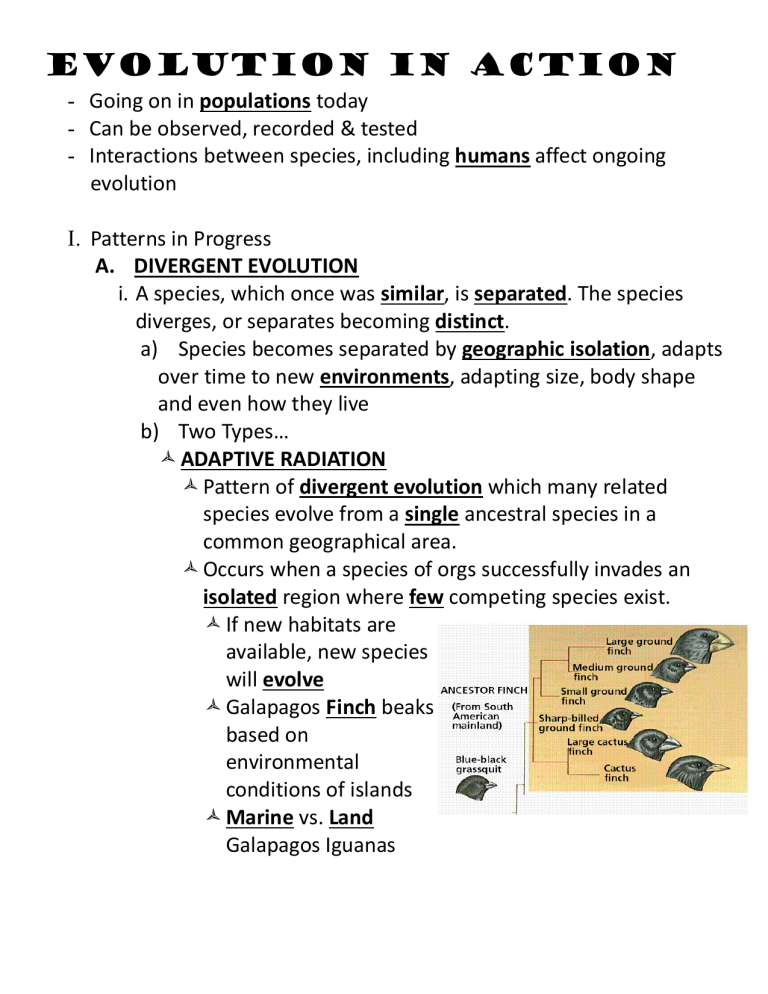
Evolution in Action
Going on in populations today
Can be observed, recorded & tested
Interactions between species, including humans affect ongoing evolution
I.
Patterns in Progress
A.
DIVERGENT EVOLUTION
i.
A species, which once was similar, is separated. The species diverges, or separates becoming distinct.
a) Species becomes separated by geographic isolation, adapts over time to new environments, adapting size, body shape and even how they live
b) Two Types…
ADAPTIVE RADIATION
Pattern of divergent evolution which many related species evolve from a single ancestral species in a common geographical area.
Occurs when a species of orgs successfully invades an
isolated region where few competing species exist.
If new habitats are available, new species will evolve
Galapagos Finch beaks based on environmental conditions of islands
Marine vs. Land
Galapagos Iguanas
B.
CONVERGENT EVOLUTION
i.
Pattern of evolution in which different organisms evolve similar traits
a) Occurs when unrelated species occupy similar environments in different parts of the world.
b) Because of similar environmental pressures, orgs share same pressures of natural selection
II.
ARTIFICIAL SELECTION
A.
Human breeder chooses individuals to mate
B.
Steers evolution in a direction predetermined by humans
i.
Dog breeds
a) Protection, hunting, companionship
ii.
Agriculture
a) Produce more crops, healthier crops, bigger crops
III.
COEVOLUTION
A.
Joint change in two or more species in close interaction with each other
B.
2 or more evolve
adaptations to each others’ influence...
i.
Predators & prey
ii.
Parasites & hosts
Pt 2 - Natural Selection and
Species Formation Patterns
I.
Natural Selection (3 Types)
A.
STABILIZING SELECTION
i.
Individuals with the average form of a trait have the highest fitness
a) Average = Optimum balance of good/bad
b) Extreme traits = lower fitness
ii.
Example: Lizards
a) Average size tails are best
Fast enough and small enough to avoid predators
Larger lizards easily spotted, small lizards not fast enough
iii.
**Most common form of natural selection in most traits of most species
B.
DISRUPTIVE SELECTION
i.
Individuals with either extreme variations of a trait have greater fitness than the average form
ii.
Example: Limpets
a) Limpets (marine shellfish) are found in variety of colors from dark brown to nearly white
Dark brown blend with dark rocks, avoiding predators
White blend with barnacles, avoiding predators
Intermediate colors are easily seen and eaten
C.
DIRECTIONAL SELECTION
i.
Individuals that display a more extreme form of a trait have a greater fitness than any other form
a) Example: Anteaters
Longer tongues are at an advantage for eating termites
Shorter and average tongues, not as good
Over time, long tongues are naturally favored
II.
Species Formation
A.
MORPHOLOGICAL CONCEPT OF SPECIES
i.
Species are defined according to structure and appearance
a) Very limited application due to phenotypic differences btwn members of same species
B.
BIOLOGICAL SPECIES CONCEPT
i.
Species is a population of orgs that can successfully interbreed but cannot breed with other groups
a) Limited to only defining species that are currently alive.
b) Also limited to species that reproduce sexually
Cannot test breeding of extinct species
C.
Modern scientists use a combination of both concepts to truly define a species.
D.
Isolation & Speciation
i.
GEOGRAPHIC ISOLATION
a) Physical separation of members of a population
b) Causes a stop in gene flow between isolated members of population, eventually drifting genetics far enough apart to become incompatible for mating
c) ALLOPATRIC SPECIATION
Occurs when species arise as a result of geographic
isolation
Allopatric = “Different Homelands”
ii.
REPRODUCTIVE ISOLATION
a) Isolation due to reproductive barrier preventing successful breeding
b) Often due to disruptive selection in which extreme traits are favored for fitness
c) Two types...
PREZYGOTIC ISOLATION
Species are incompatible before birth
POSTZYGOTIC ISOLATION
Species become incompatible after birth
d) SYMPATRIC SPECIATION
Occurs when two sub-populations become reproductively
isolated within the same geographic area
III.
Rates of Speciation
A.
Most speciation occurs over millions of years
B.
Some species can form more rapidly (1000's of years)
C.
GRADUALISM
i.
Idea that speciation occurs at a regular, gradual rate
ii.
New species are formed are regular intervals throughout time
iii.
This theory is not accepted as scientifically sound
D.
PUNCTUATED EQUILIBRIUM
i.
Idea that speciation occurs in bursts, relative to the geologic
time scale
ii.
Much evidence in fossil record to support this
a) Fossils show long periods of time where species go
without change, as well as short periods of time with tons of change



